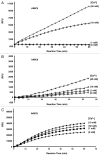Sheathing the swords of death: post-translational modulation of plant metacaspases
- PMID: 22112449
- PMCID: PMC3337205
- DOI: 10.4161/psb.6.12.18247
Sheathing the swords of death: post-translational modulation of plant metacaspases
Abstract
Plant metacaspases (MCPs) are conserved cysteine proteases that have been postulated as regulators of programmed cell death (PCD). Although MCPs have been proven to have PCD relevant functions in multiple species ranging from fungi to plants, how these proteases are modulated in vivo remains unclear. Aside from demonstrating that these proteases are distinct from metazoan caspases due to their different target site specificities, how these proteases are used to tightly regulate cell death progression is a key question that remains to be resolved. Some recent studies on the biochemical characteristics of type-II MCP activities in Arabidopsis may begin to shed additional light on this aspect. The in vitro catalytic activities of recombinant AtMC4, AtMC5 and AtMC8 are found to be Ca(2+)-dependent while recombinant AtMC9 is active under mildly acidic conditions and not dependent on stimulation by Ca(2+). Alterations of cellular pH and Ca(2+) concentration commonly occur during various stresses and may help to orchestrate differential activation of latent MCPs under these conditions. Recent peptide mapping for recombinant AtMC4 (also called Metacaspase-2d) followed by site-specific mutagenesis studies have revealed multiple potential self-cleavage sites with the identification of a conserved lysine residue (Lys-225) as the key position for enzyme function both in vitro and in vivo. The multiple self-cleavage sites in MCPs may also facilitate desensitization of these proteases and can provide a means for fine-tuning their proteolytic activities in order to achieve more sensitive control of downstream processes.
© 2011 Landes Bioscience
Figures


Comment on
- Watanabe N, Lam E. Calcium-dependent activation and autolysis of Arabidopsis metacaspase 2d. J Biol Chem. 2011;286 doi: 10.1074/jbc.M110.194340.
Similar articles
-
Calcium-dependent activation and autolysis of Arabidopsis metacaspase 2d.J Biol Chem. 2011 Mar 25;286(12):10027-40. doi: 10.1074/jbc.M110.194340. Epub 2011 Jan 5. J Biol Chem. 2011. PMID: 21209078 Free PMC article.
-
Domain swap between two type-II metacaspases defines key elements for their biochemical properties.Plant J. 2018 Dec;96(5):921-936. doi: 10.1111/tpj.14079. Epub 2018 Oct 23. Plant J. 2018. PMID: 30176090
-
Metacaspase activity of Arabidopsis thaliana is regulated by S-nitrosylation of a critical cysteine residue.J Biol Chem. 2007 Jan 12;282(2):1352-8. doi: 10.1074/jbc.M608931200. Epub 2006 Nov 16. J Biol Chem. 2007. PMID: 17110382
-
Regulating the reapers: activating metacaspases for programmed cell death.Trends Plant Sci. 2012 Aug;17(8):487-94. doi: 10.1016/j.tplants.2012.05.003. Epub 2012 Jun 2. Trends Plant Sci. 2012. PMID: 22658651 Review.
-
Plant life needs cell death, but does plant cell death need Cys proteases?FEBS J. 2017 May;284(10):1577-1585. doi: 10.1111/febs.14034. Epub 2017 Feb 26. FEBS J. 2017. PMID: 28165668 Review.
Cited by
-
Grapevine VpPR10.1 functions in resistance to Plasmopara viticola through triggering a cell death-like defence response by interacting with VpVDAC3.Plant Biotechnol J. 2018 Aug;16(8):1488-1501. doi: 10.1111/pbi.12891. Epub 2018 Mar 8. Plant Biotechnol J. 2018. PMID: 29377445 Free PMC article.
-
Comparative structural analysis of the caspase family with other clan CD cysteine peptidases.Biochem J. 2015 Mar 1;466(2):219-32. doi: 10.1042/BJ20141324. Biochem J. 2015. PMID: 25697094 Free PMC article. Review.
-
Structural and functional diversity of caspase homologues in non-metazoan organisms.Protoplasma. 2018 Jan;255(1):387-397. doi: 10.1007/s00709-017-1145-5. Epub 2017 Jul 25. Protoplasma. 2018. PMID: 28744694 Free PMC article. Review.
-
Calcium Signaling in Plant Programmed Cell Death.Cells. 2021 May 2;10(5):1089. doi: 10.3390/cells10051089. Cells. 2021. PMID: 34063263 Free PMC article. Review.
-
Two aspartate residues at the putative p10 subunit of a type II metacaspase from Nicotiana tabacum L. may contribute to the substrate-binding pocket.Planta. 2014 Jan;239(1):147-60. doi: 10.1007/s00425-013-1975-0. Planta. 2014. PMID: 24121807
References
Publication types
MeSH terms
Substances
LinkOut - more resources
Full Text Sources
Molecular Biology Databases
Miscellaneous
